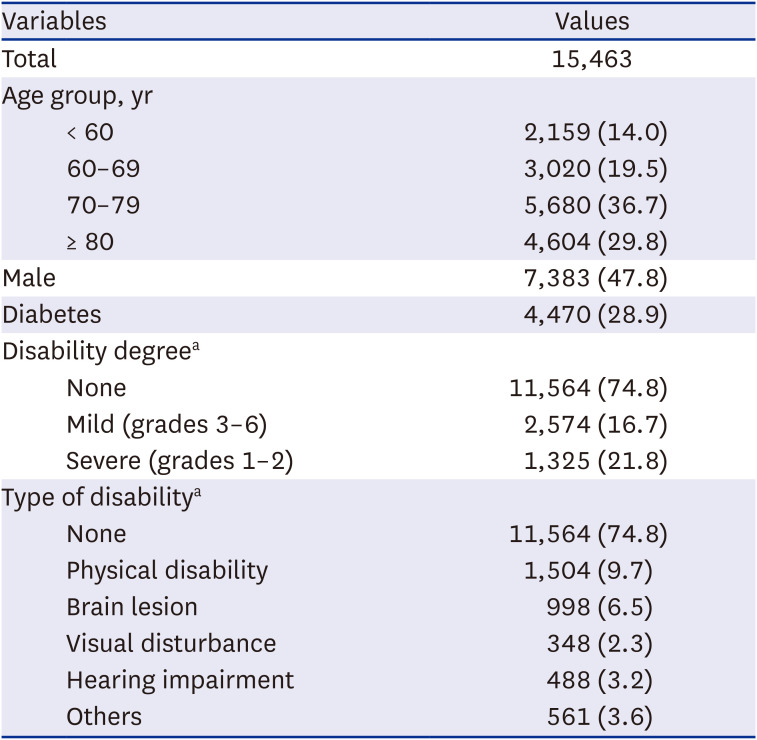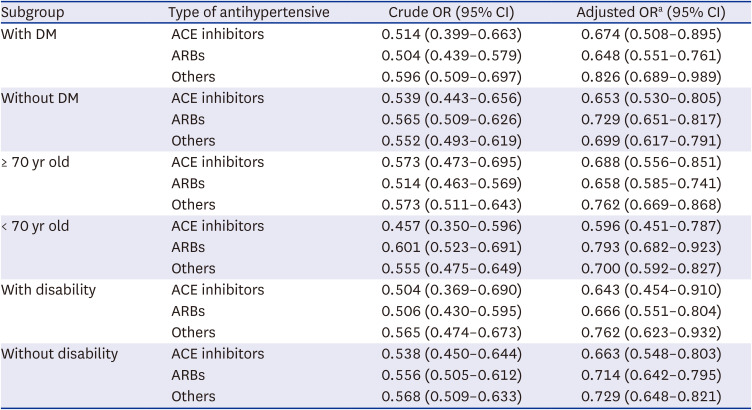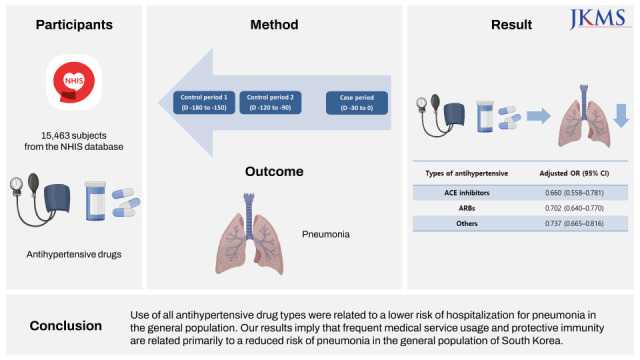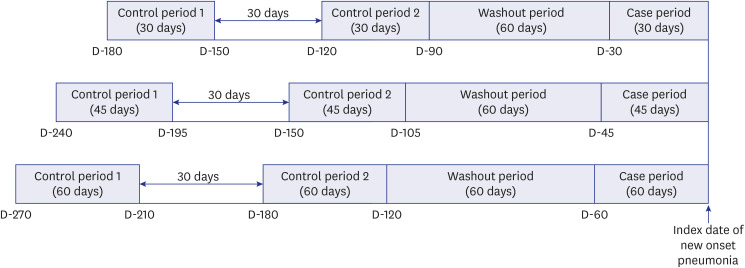1. Buzzo AR, Roberts C, Mollinedo LG, Quevedo JM, Casas GL, Soldevilla JM. Morbidity and mortality of pneumonia in adults in six Latin American countries. Int J Infect Dis. 2013; 17(9):e673–e677. PMID:
23558317.

2. Statistics Korea. 2020 cause of death statistics. Updated 2021. Accessed February 24, 2022.
http://kosis.kr
.
3. Schmedt N, Heuer OD, Häckl D, Sato R, Theilacker C. Burden of community-acquired pneumonia, predisposing factors and health-care related costs in patients with cancer. BMC Health Serv Res. 2019; 19(1):30. PMID:
30642312.

4. Lim WS. Pneumonia—overview. Janes SM, editor. Encyclopedia of Respiratory Medicine. Amsterdam, Netherlands: Elsevier;2022. p. 185–197.
5. Huang KH, Kuo WY, Kuan YH, Chang YC, Tsai TH, Lee CY. Risk of pneumonia is associated with antipsychotic drug use among older patients with Parkinson’s disease: a case-control study. Int J Med Sci. 2021; 18(15):3565–3573. PMID:
34522183.

6. Liapikou A, Cilloniz C, Torres A. Drugs that increase the risk of community-acquired pneumonia: a narrative review. Expert Opin Drug Saf. 2018; 17(10):991–1003. PMID:
30196729.

7. Restrepo MI, Mortensen EM, Anzueto A. Common medications that increase the risk for developing community-acquired pneumonia. Curr Opin Infect Dis. 2010; 23(2):145–151. PMID:
20075727.

8. van de Garde EM, Souverein PC, van den Bosch JM, Deneer VH, Leufkens HG. Angiotensin-converting enzyme inhibitor use and pneumonia risk in a general population. Eur Respir J. 2006; 27(6):1217–1222. PMID:
16455828.

9. Liu CL, Shau WY, Wu CS, Lai MS. Angiotensin-converting enzyme inhibitor/angiotensin II receptor blockers and pneumonia risk among stroke patients. J Hypertens. 2012; 30(11):2223–2229. PMID:
22929610.

10. van de Garde EM, Souverein PC, Hak E, Deneer VH, van den Bosch JM, Leufkens HG. Angiotensin-converting enzyme inhibitor use and protection against pneumonia in patients with diabetes. J Hypertens. 2007; 25(1):235–239. PMID:
17143196.

11. Caldeira D, Alarcão J, Vaz-Carneiro A, Costa J. Risk of pneumonia associated with use of angiotensin converting enzyme inhibitors and angiotensin receptor blockers: systematic review and meta-analysis. BMJ. 2012; 345:e4260. PMID:
22786934.

12. Yun JH, Rhee SY, Chun S, Kim HS, Oh BM. Association between antihypertensive use and hospitalized pneumonia in patients with stroke: a Korean nationwide population-based cohort study. J Korean Med Sci. 2022; 37(15):e112. PMID:
35437963.

13. Lee J, Lee JS, Park SH, Shin SA, Kim K. Cohort profile: the National Health Insurance Service-National Sample Cohort (NHIS-NSC), South Korea. Int J Epidemiol. 2017; 46(2):e15. PMID:
26822938.

14. Lee JS, Chui PY, Ma HM, Auyeung TW, Kng C, Law T, et al. Does low dose angiotensin converting enzyme inhibitor prevent pneumonia in older people with neurologic dysphagia--a randomized placebo-controlled trial. J Am Med Dir Assoc. 2015; 16(8):702–707. PMID:
26123256.

15. Ohkubo T, Chapman N, Neal B, Woodward M, Omae T, Chalmers J, et al. Effects of an angiotensin-converting enzyme inhibitor-based regimen on pneumonia risk. Am J Respir Crit Care Med. 2004; 169(9):1041–1045. PMID:
14990394.

16. Sekizawa K, Matsui T, Nakagawa T, Nakayama K, Sasaki H. ACE inhibitors and pneumonia. Lancet. 1998; 352(9133):1069.

17. Wang HC, Lin CC, Lau CI, Chang A, Kao CH. Angiotensin-converting enzyme inhibitors and bacterial pneumonia in patients with Parkinson disease. Mov Disord. 2015; 30(4):593–596. PMID:
25641619.

18. Shinohara Y, Origasa H. Post-stroke pneumonia prevention by angiotensin-converting enzyme inhibitors: results of a meta-analysis of five studies in Asians. Adv Ther. 2012; 29(10):900–912. PMID:
22983755.

19. Williams VR, Scholey JW. Angiotensin-converting enzyme 2 and renal disease. Curr Opin Nephrol Hypertens. 2018; 27(1):35–41. PMID:
29045335.

20. Paul M, Poyan Mehr A, Kreutz R. Physiology of local renin-angiotensin systems. Physiol Rev. 2006; 86(3):747–803. PMID:
16816138.

21. Just PM. The positive association of cough with angiotensin-converting enzyme inhibitors. Pharmacotherapy. 1989; 9(2):82–87. PMID:
2657676.

22. Tomaki M, Ichinose M, Miura M, Hirayama Y, Kageyama N, Yamauchi H, et al. Angiotensin converting enzyme (ACE) inhibitor-induced cough and substance P. Thorax. 1996; 51(2):199–201. PMID:
8711657.

23. El Solh AA, Saliba R. Pharmacologic prevention of aspiration pneumonia: a systematic review. Am J Geriatr Pharmacother. 2007; 5(4):352–362. PMID:
18179994.

24. Ikeda J, Kojima N, Saeki K, Ishihara M, Takayama M. Perindopril increases the swallowing reflex by inhibiting substance P degradation and tyrosine hydroxylase activation in a rat model of dysphagia. Eur J Pharmacol. 2015; 746:126–131. PMID:
25445054.

25. Arai T, Yasuda Y, Takaya T, Toshima S, Kashiki Y, Yoshimi N, et al. ACE inhibitors and symptomless dysphagia. Lancet. 1998; 352(9122):115–116. PMID:
9672283.

26. El-Hashim AZ, Amine SA. The role of substance P and bradykinin in the cough reflex and bronchoconstriction in guinea-pigs. Eur J Pharmacol. 2005; 513(1-2):125–133. PMID:
15878717.

27. Nataraj C, Oliverio MI, Mannon RB, Mannon PJ, Audoly LP, Amuchastegui CS, et al. Angiotensin II regulates cellular immune responses through a calcineurin-dependent pathway. J Clin Invest. 1999; 104(12):1693–1701. PMID:
10606623.

28. Di Raimondo D, Tuttolomondo A, Buttà C, Miceli S, Licata G, Pinto A. Effects of ACE-inhibitors and angiotensin receptor blockers on inflammation. Curr Pharm Des. 2012; 18(28):4385–4413. PMID:
22283779.

29. Shrikrishna D, Astin R, Kemp PR, Hopkinson NS. Renin-angiotensin system blockade: a novel therapeutic approach in chronic obstructive pulmonary disease. Clin Sci (Lond). 2012; 123(8):487–498. PMID:
22757959.

30. Dublin S, Walker RL, Jackson ML, Nelson JC, Weiss NS, Jackson LA. Angiotensin-converting enzyme inhibitor use and pneumonia risk in community-dwelling older adults: results from a population-based case-control study. Pharmacoepidemiol Drug Saf. 2012; 21(11):1173–1182. PMID:
22949094.

31. Liu CL, Shau WY, Chang CH, Wu CS, Lai MS. Pneumonia risk and use of angiotensin-converting enzyme inhibitors and angiotensin II receptor blockers. J Epidemiol. 2013; 23(5):344–350. PMID:
23912052.

32. Gillespie SH, Balakrishnan I. Pathogenesis of pneumococcal infection. J Med Microbiol. 2000; 49(12):1057–1067. PMID:
11129716.

33. DiBardino DM, Wunderink RG. Aspiration pneumonia: a review of modern trends. J Crit Care. 2015; 30(1):40–48. PMID:
25129577.

34. Lansbury L, Lim B, McKeever TM, Lawrence H, Lim WS. Non-invasive pneumococcal pneumonia due to vaccine serotypes: a systematic review and meta-analysis. eClinicalMedicine. 2022; 44:101271. PMID:
35112072.

35. Said MA, Johnson HL, Nonyane BA, Deloria-Knoll M, O’Brien KL, Andreo F, et al. Estimating the burden of pneumococcal pneumonia among adults: a systematic review and meta-analysis of diagnostic techniques. PLoS One. 2013; 8(4):e60273. PMID:
23565216.

36. Imamura Y, Miyazaki T, Watanabe A, Tsukada H, Nagai H, Hasegawa Y, et al. Prospective multicenter survey for Nursing and Healthcare-associated Pneumonia in Japan. J Infect Chemother. 2022; 28(8):1125–1130. PMID:
35414437.

37. Andersen CT, Langendorf C, Garba S, Sayinzonga-Makombe N, Mambula C, Mouniaman I, et al. Risk of community- and hospital-acquired bacteremia and profile of antibiotic resistance in children hospitalized with severe acute malnutrition in Niger. Int J Infect Dis. 2022; 119:163–171. PMID:
35346836.

38. Jaradeh S. Neurophysiology of swallowing in the aged. Dysphagia. 1994; 9(4):218–220. PMID:
7805419.

39. Tracy JF, Logemann JA, Kahrilas PJ, Jacob P, Kobara M, Krugler C. Preliminary observations on the effects of age on oropharyngeal deglutition. Dysphagia. 1989; 4(2):90–94. PMID:
2640185.

40. Ren J, Shaker R, Kusano M, Podvrsan B, Metwally N, Dua KS, et al. Effect of aging on the secondary esophageal peristalsis: presbyesophagus revisited. Am J Physiol. 1995; 268(5 Pt 1):G772–G779. PMID:
7762661.

41. Nilsson H, Ekberg O, Olsson R, Hindfelt B. Quantitative aspects of swallowing in an elderly nondysphagic population. Dysphagia. 1996; 11(3):180–184. PMID:
8755461.

42. Benfield T, Jensen JS, Nordestgaard BG. Influence of diabetes and hyperglycaemia on infectious disease hospitalisation and outcome. Diabetologia. 2007; 50(3):549–554. PMID:
17187246.

43. Jensen AV, Faurholt-Jepsen D, Egelund GB, Andersen SB, Petersen PT, Benfield T, et al. Undiagnosed diabetes mellitus in community-acquired pneumonia: a prospective cohort study. Clin Infect Dis. 2017; 65(12):2091–2098. PMID:
29095981.
44. Pratt N, Roughead EE, Ramsay E, Salter A, Ryan P. Risk of hospitalization for hip fracture and pneumonia associated with antipsychotic prescribing in the elderly: a self-controlled case-series analysis in an Australian health care claims database. Drug Saf. 2011; 34(7):567–575. PMID:
21663332.

45. Trifirò G, Gambassi G, Sen EF, Caputi AP, Bagnardi V, Brea J, et al. Association of community-acquired pneumonia with antipsychotic drug use in elderly patients: a nested case-control study. Ann Intern Med. 2010; 152(7):418–425. PMID:
20368647.

46. Herzig SJ, LaSalvia MT, Naidus E, Rothberg MB, Zhou W, Gurwitz JH, et al. Antipsychotics and the risk of aspiration pneumonia in individuals hospitalized for nonpsychiatric conditions: a cohort study. J Am Geriatr Soc. 2017; 65(12):2580–2586. PMID:
29095482.









 PDF
PDF Citation
Citation Print
Print





 XML Download
XML Download